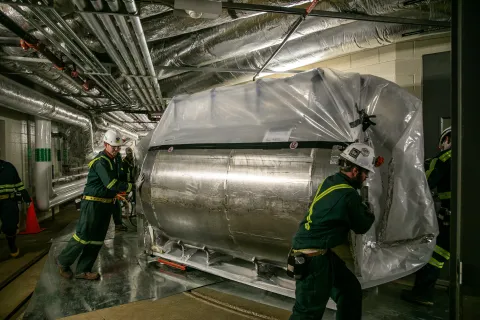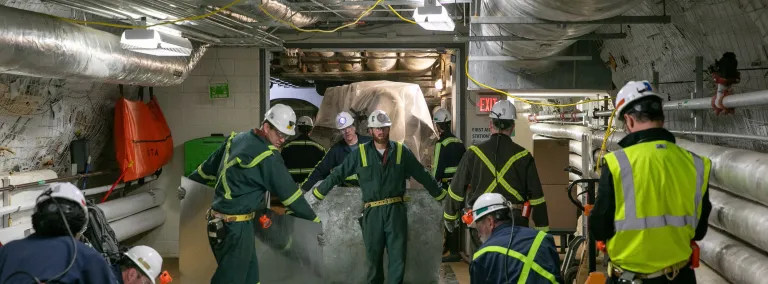The engineering of world-class science
SURF engineers play a vital role in design and installation of world-leading underground experiments
Charles Maupin (ME 10) has a 90-minute commute to and from his job at the Sanford Underground Research Facility (SURF) in Lead, SD. Most people with that kind of drive might listen to podcasts or call friends and family to catch up. But not Charles.
During most of his drives to and from his family’s ranch in Hulett, WY, he’s thinking about how to overcome a challenge he encountered while operating the most sensitive dark matter detector in the world – which happens to be a mile underground.
“When I graduated, I knew I wanted to stay close to home so I could help out on the ranch, but I never anticipated I’d be working at an underground lab,” he said. “To most people, this might be as far from the ranch as you can get.”
But maybe not as far as you’d think. Charles and his coworker Jake Davis (ME 10), fellow rancher and former classmate, have drawn some conclusions between the hard work and problem-solving nature of ranching and engineering a complex underground science experiment.
“Growing up on a ranch, you have to find ways to solve problems and adapt to changing conditions,” said Jake. “You have to be curious about how things work.”
Jake and Charles have worked together since the assembly phase of LUX-ZEPLIN (LZ), the world’s leading experiment in the race to directly detect dark matter, which many scientists believe makes up 85 percent of our universe. LZ contains more than 10 metric tons of liquid xenon. Researchers believe dark matter particles streaming through the universe will interact with the xenon atoms. Hosting the experiment underground helps block out cosmic rays that make rare dark matter interactions difficult to detect.
“Some things we just don’t know; but unless we go after the answers to those questions, we’ll never find out,” said Jake. “If you look at how far mankind has come in the last 100 years, it’s because people were asking these kinds of questions.”
The importance of the work being done at SURF is just one reward for Jake and Charles. For engineers who enjoy solving problems and who don’t shy away from trying something for the first time, designing and installing experiments at an underground lab is the ultimate “office.”
“For me, it’s the challenge,” said Charles, who has worked on LZ from the design phase, to installation, and now operations. “Pretty much every day, I run into a problem where I can’t just buy the part I need; I have to design it myself.”
That skill is one of the things both men say set their education at South Dakota Mines apart from other engineering programs.
“At Mines, you learn how to take a problem and break it down into the fundamental elements of what you’re trying to solve,” said Jake, who now leads surface operations and utilities at the lab.
Charles said programs like CAMP and the senior design project are what differentiated his experience at Mines.
“You can sit down and read a book and do problems at your desk, but the real world application is what prepares you.”
He remembers Dr. Dan Dolan saying, “The biggest thing we teach you here is how to learn.”
“We do a lot of interesting things at SURF that are being done for the very first time and that only a few places in the world are doing,” said Charles. “So that ability to learn as you’re going is crucial.”
The fact that science experiments of this scale are happening in South Dakota is something both men take pride in.
“I’m a fifth-generation South Dakotan, and there’s definitely a sense of pride that this level of work is being done in our state,” said Jake. “There is cutting-edge science taking place here, and we’re doing it where there was an operating gold mine for more than 100 years.”
Jake and Charles are just two examples of many Mines alumni at SURF. The majority of the engineers who contribute to the work at SURF are alumni of South Dakota Mines. University faculty, specifically in the Physics Department, collaborate regularly and are instrumental to several experiments at the lab. Undergraduate and graduate students have been able to participate in ground-breaking research because of Mines’ proximity to the lab.
Besides the world's leading dark matter detector, SURF is also home to the largest physics experiment ever undertaken on American soil. The Long Baseline Neutrino Experiment and the Deep Underground Neutrino Experiment (LBNF/DUNE) are run by the Fermi National Accelerator Laboratory. The massive neutrino detectors of DUNE will be housed at SURF inside huge underground caverns. The South Dakota detectors will be the largest of their type ever built. They will use 70,000 tons of liquid argon and advanced technology to record neutrino interactions with unprecedented precision. The size and complexity of LBNF/DUNE requires huge amounts of engineering. Jake, Charles, and a range of Mines alumni are supporting the effort. For those assisting on the project, it’s the opportunity of a lifetime.
“I’m an engineer who loves learning, and I never want to stop learning how to do new things,” said Jake. “What better place to do that than an underground physics lab where you’re trying to discover dark matter or explore the mysteries of neutrinos?”
The article was first published by South Dakota Mines in The Hardrock magazine.




